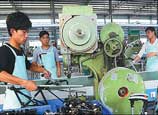
If more direct investments in the US and EU from Chinese companies can take place in the next few years, China will be better adapted to the changes in trade environment brought about by a US-EU FTA.
Finally, although the US and EU lowering mutual trade barriers will have a side effect on Chinese exports, the dominant factor is the core competitiveness of Chinese products.
When NAFTA was launched two decades ago, many Chinese experts feared that it would bring severe woes to China's exports.
But in fact, the growth rate of China's exports to the US still exceeds that of Mexico's. In the process of EU integration, China has surpassed France as the largest trading partner of Germany.
These examples show that China could still have certain advantages even after the establishment of a US-EU FTA. However, the question is: how to maintain and create new competitive advantages?
This will be a major challenge China has to face in the years to come.
The author is co-director of the China-US-EU Study Center under the China Association of International Trade. opinion@globaltimes.com.cn

















 China's 'leftover women' phenomenon arouses heated debate in West
China's 'leftover women' phenomenon arouses heated debate in West


![]()
